issue contents
September 2011 issue
The Seattle Structural Genomics Center for Infectious Disease

Cover illustration: Members of the Seattle Structural Genomics Center for Infectious Disease consortium and a variety of structures, all of which are contained in the SSGCID special issue. The image was prepared by Thomas C. Leeper and Darren W. Begley.
introduction
Open  access
access
 access
accessAn introduction and overview of the focus, goals and overall mission of the Seattle Structural Genomics Center for Infectious Disease (SSGCID) is given.
laboratory communications
Open  access
access
 access
accessFor structural biology applications, protein-construct engineering is guided by comparative sequence analysis and structural information, which allow the researcher to better define domain boundaries for terminal deletions and nonconserved regions for surface mutants. A database software application called Gene Composer has been developed to facilitate construct design.
Open  access
access
 access
accessAn overview of one salvage strategy for high-value SSGCID targets is given.

Loading metrics information...
Download citation


Download citation



Loading metrics information...
Open  access
access
 access
accessAn overview of the methods used for high-throughput cloning and protein-expression screening of SSGCID hexahistidine recombinant proteins is provided. It is demonstrated that screening for recombinant proteins that are highly recoverable from immobilized metal-affinity chromatography improves the likelihood that a protein will produce a structure.

Loading metrics information...
Download citation


Download citation



Loading metrics information...
Open  access
access
 access
accessThe rescue of protein-expression levels by cloning genes into MBP-fusion vector is described.
Open  access
access
 access
accessAn overview of the standard SSGCID protein-purification protocol is given and success rates and cleavage alternatives are discussed.
Open  access
access
 access
accessThe Protein Maker instrument addresses a critical bottleneck in structural genomics by allowing automated purification and buffer testing of multiple protein targets in parallel with a single instrument. Here, the use of this instrument to (i) purify multiple influenza-virus proteins in parallel for crystallization trials and (ii) identify optimal lysis-buffer conditions prior to large-scale protein purification is described.
Open  access
access
 access
accessSSGCID protein crystals were salvaged and stored using the MPCS Plug Maker and CrystalCards when high-throughput traditional sitting-drop vapor diffusion initially failed.
Open  access
access
 access
accessA set of 44 protein targets was used to test expression in the wheat germ cell-free system, the vast majority of which were expressed and soluble in this system; further increases in solubility were achieved by addition of the NVoy polymer.
structural communications

Loading metrics information...
Download citation


Download citation



Loading metrics information...
Open  access
access
 access
accessPhosphopantetheine adenylyltransferase (PPAT) reversibly converts ATP and 4′-phosphopantetheine into dephospho-coenzyme A and pyrophosphate. Crystal structures are presented of PPAT from B. pseudomallei, the pathogenic bacterium that causes melioidosis.

Loading metrics information...
Download citation


Download citation



Loading metrics information...
Open  access
access
 access
accessThe pathogenic fungus C. immitis causes coccidioidomycosis, a potentially fatal disease. Here, apo and glutathione-bound crystal structures of a previously uncharacterized protein from C. immitis that appears to be a ζ-class glutathione S-transferase are presented.

Loading metrics information...
Download citation


Download citation



Loading metrics information...
Open  access
access
 access
accessAn ensemble of crystal structures are reported for 2,3-bisphosphoglycerate-dependent phosphoglycerate mutase from B. pseudomallei. The structures include two vanadate complexes, revealing the structure of a close analogue of the transition state for phosphate transfer.

Loading metrics information...
Download citation


Download citation



Loading metrics information...
Open  access
access
 access
accessWhile other aldolases crystallize readily in the apo form, diffraction-quality crystals of B. henselae aldolase could only be obtained in the presence of the native substrate. The quaternary structure is tetrameric, as is typical of aldolases.
PDB reference: fructose bisphosphate aldolase, 3mmt

Loading metrics information...
Download citation


Download citation



Loading metrics information...
Open  access
access
 access
accessThe eukaryotic parasite E. cuniculi expresses a fructose bisphosphate aldolase that crystallizes readily in the presence of the partial substrate analog phosphate. This aldolase–phosphate structure and that of the sugar-bound Schiff base are reported. E. cuniculi aldolase displays a dimeric structure rather than the expected tetrameric quaternary structure.

Loading metrics information...
Download citation


Download citation



Loading metrics information...
Open  access
access
 access
accessThe first crystal structure is reported of a glutaryl-CoA dehydrogenase in the apo state without flavin adenine dinucleotide cofactor bound. Additional structures with small molecules complexed in the catalytic active site were obtained by fragment-based screening.

Loading metrics information...
Download citation


Download citation



Loading metrics information...
Open  access
access
 access
accessStructural characterization of the bifunctional enzyme dihydrofolate reductase-thymidylate synthase from B. bovis in the apo state and complexed with antifolate inhibitors in both enzymatic active sites is reported.

Loading metrics information...
Download citation


Download citation



Loading metrics information...
Open  access
access
 access
accessB. henselae is the etiological agent responsible for cat scratch fever (bartonellosis). The crystal structure of the smaller of the two Nudix hydrolases encoded in the genome of B. henselae, Bh-MutT, was determined to 2.1 Å resolution.
PDB reference: Nudix hydrolase, 3hhj

Loading metrics information...
Download citation


Download citation



Loading metrics information...
Open  access
access
 access
accessCrystal structures of a cyclin-dependent kinase from G. lamblia are presented in both apo and AMP-bound forms.

Loading metrics information...
Download citation


Download citation



Loading metrics information...
Open  access
access
 access
accessA 2.15 Å resolution apo structure of thymidylate kinase from E. chaffeensis is reported.
PDB reference: thymidylate kinase, 3ld9

Loading metrics information...
Download citation


Download citation



Loading metrics information...
Open  access
access
 access
accessThe crystal structure of the ubiquitous glycolytic enzyme triosephosphate isomerase from C. parvum in the open-loop conformation was determined at a resolution of 1.55 Å.
PDB reference: triosephosphate isomerase, 3krs

Loading metrics information...
Download citation


Download citation



Loading metrics information...
Open  access
access
 access
accessThe 1.6 Å resolution crystal structure of nitrilotriacetate monooxygenase component B (NTA-MoB) from M. thermoresistibile is presented, revealing a highly conserved C-terminal tail that may modulate the activity of NTA-MoB in mycobacteria.
PDB reference: NTA-MoB, 3nfw

Loading metrics information...
Download citation


Download citation



Loading metrics information...
Open  access
access
 access
accessThe structure of a β-lactamase-like protein from B. melitensis was solved independently using two data sets with anomalous signal. Anomalous Fourier maps could confirm the identity of two metal ions in the active site. AMP-bound and GMP-bound structures provide hints to the possible function of the protein.

Loading metrics information...
Download citation


Download citation



Loading metrics information...
Open  access
access
 access
accessThe 1.75 Å resolution crystal structure of aldose reductase from G. lamblia, the etiological agent of giardiasis, is reported.
PDB reference: aldose reductase, 3krb

Loading metrics information...
Download citation


Download citation



Loading metrics information...
Open  access
access
 access
accessThe R. prowazekii 3-ketoacyl-(acyl-carrier-protein) reductase is similar to those from other prokaryotic pathogens but differs significantly from the mammalian orthologue, strengthening its case as a potential drug target.
PDB reference: 3-ketoacyl-(acyl-carrier-protein) reductase, 3f9i

Loading metrics information...
Download citation


Download citation



Loading metrics information...
Open  access
access
 access
accessFumarate hydratase is an enzyme of the tricarboxylic acid cycle, one of the metabolic pathways characteristic of the mitochondria. The structure of R. prowazekii class II fumarate hydratase is reported at 2.4 Å resolution and is compared with the available structure of the human homolog.
PDB reference: fumarate hydratase, 3gtd

Loading metrics information...
Download citation


Download citation



Loading metrics information...
Open  access
access
 access
accessB. melitensis is a NIAID Category B microorganism that is responsible for brucellosis and is a potential agent for biological warfare. Here, the solution structure of the 116-residue arsenate reductase-related protein Bm-YffB (BR0369) from this organism is reported.
PDB reference: Bm-YffB, 2kok

Loading metrics information...
Download citation


Download citation



Loading metrics information...
Open  access
access
 access
accessThe high-resolution NMR structure of the acyl-carrier protein from the pathogen B. burgdorferi determined to a r.m.s. deviation of 0.4 Å over the protein backbone is reported. The NMR structure was determined using multidimensional NMR spectroscopy and consists of four α-helices and two 310-helices. Structural comparison reveals that this protein is highly similar to the acyl-carrier protein from A. aeolicus.
PDB reference: BobuA.00658.a, 2kwl

Loading metrics information...
Download citation


Download citation



Loading metrics information...
Open  access
access
 access
accessNMR structures of the glutaredoxin (GLXR) domains from Br. melitensis and Ba. henselae have been determined as part of the SSGCID initiative. Comparison of the domains with known structures reveals overall structural similarity between these proteins and previously determined E. coli GLXR structures, with minor changes associated with the position of helix 1 and with regions that diverge from similar structures found in the closest related human homolog.

Loading metrics information...
Download citation


Download citation



Loading metrics information...
Open  access
access
 access
accessOne third of the world's human population is infected with M. tuberculosis, the etiological agent responsible for tuberculosis (TB). Here, the solution structure of the small iron-binding protein from this organism, rubredoxin B (Rv3250c), is reported in the zinc-substituted form.
PDB reference: rubredoxin B, 2kn9

Loading metrics information...
Download citation


Download citation



Loading metrics information...
Open  access
access
 access
accessCystathionine γ-synthase (CGS) is a transferase that catalyzes the reaction between O4-succinyl-L-homoserine and L-cysteine to produce L-cystathionine and succinate. The crystal structure of CGS from M. ulcerans is presented covalently linked to the cofactor pyridoxal phosphate (PLP). A second structure contains PLP as well as a highly ordered HEPES molecule in the active site acting as a pseudo-ligand. This is the first structure ever reported from the pathogen M. ulcerans.


 journal menu
journal menu

















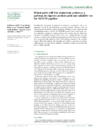



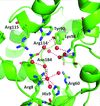



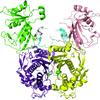

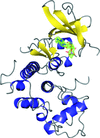





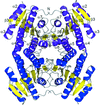


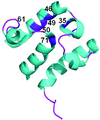
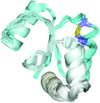


![[publBio]](http://journals.iucr.org/logos/publbio.gif)




